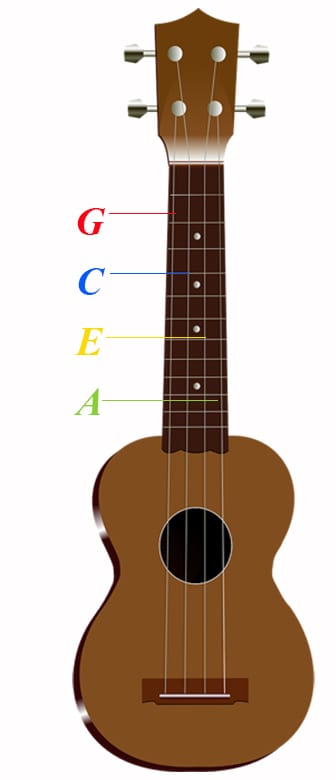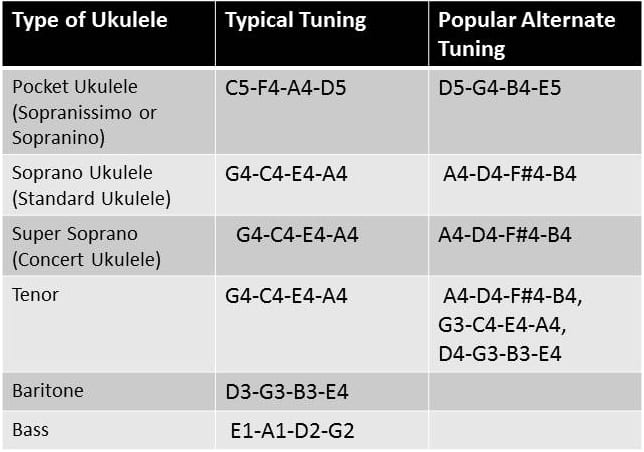 OR Images / DigitalVision / Getty Images
OR Images / DigitalVision / Getty Images
One of the first things you need to learn when taking ukulele lessons is how to tune a ukulele. Basic ukulele tuning is a must if you want it to sound good, and is pretty standard once you get the hang of it. After all, the songs you want to play won’t sound right if your ukulele is not properly in tune. So how do you tune ukulele strings? Is there a specific ukulele tuner? We’re glad you asked.
In this article, we’ll provide a step-by-step guide on beginner ukulele tuning, whether you are looking to learn how to tune a ukulele without a tuner, by ear, or with a tuner or ukulele tuning app. Tuning your instrument may seem tricky at first, but it’ll become second nature once you get the hang of it.
This guide will teach you how to tune a ukulele to standard tuning and how to tune tenor, soprano, and bass ukuleles. Because there are so many ways to learn to tune your ukulele for the best sound quality of your notes, we suggest trying out all of the options to determine which method you gravitate toward most. As long as your ukulele is in tune, there is no right or wrong way to go about it.
If you’re looking for something specific, you can jump around throughout the guide here:
What Notes are the 4 Strings on a Ukulele?
A standard ukulele has four strings: G, C, E, and A.
- The G string is the bottom string and is tuned to a higher pitch than the others.
- The C string is the next highest-pitched string.
- The E string is the third-highest pitched string.
- The A string is the top-most and highest pitched string of a standard ukulele.
Ready to learn more about how to know if your ukulele is tuned? Sign up for ukulele lessons! Not only will you master everything you need to know about tuning a ukulele, but you’ll learn other helpful skills like what you see in the video below, too:
https://www.youtube.com/watch?v=sS0VxXfBRVo
How Do You Tune a Ukulele for the First Time?
If you know nothing about tuning a stringed instrument, check out this video on how to tune a guitar from world-famous guitarist and songwriter James Taylor. This video covers a lot of details about tuning in general, and you can apply the same principles to tuning a ukulele.
But before jumping into our guide on how to tune a ukulele, let’s first discuss some dos and don’ts:
- Do get acquainted with the names of the strings and the way they should sound.
- Do tune your ukulele every time you play it.
- Don’t worry if you have to tune your ukulele after playing each song–this is normal as the strings stretch.
- Do remember; turning the pegs clockwise will loosen the strings, while turning them counter-clockwise will tighten them.
- Don’t store your ukulele in places where the temperature or humidity drastically fluctuates.
- Do gently stretch your ukulele strings to warm them up.
- Don’t forget to change your strings when they begin to sound “dead.”
- Do gently wipe down your strings each time after playing.
Standard Ukulele Tuning
So how should I tune my ukulele? The ukulele strings tuning notes are typically G, C, E, and A. This has been the “standard” since the advent of the internet. Before the internet, you could find people who tune their ukulele to A, D, F#, B, or even fiddle tunings like A, D, A, D or G, C, D, G.

How to Tune a Ukulele Without a Tuner: Use a Piano
If you’re wondering how to properly tune a ukulele without a tuner, turn to your piano for help. Today, most of the books and videos you will find use G4, C4, E4, A4 as the standard ukulele tuning. The fours behind the letters represent the octave that you will find on the piano.
So if you happen to have a keyboard or a piano, C4 is known as middle C. If you tune your ukulele to match middle C, then the E above middle C, and the A above middle C, and then tune the first string to the G above middle C, you will be in what is known as standard ukulele tuning.
Here’s a good illustration of how to tune a ukulele with a piano from The Uke website.
How to Tune a Ukulele With a Tuner
So what do you do if you don’t have a piano? Well, you will need to get yourself a chromatic tuner. Knowing how to use a ukulele tuner is a key skill to master for any ukulele player. But what tuner is best?
You can purchase several brands of tuners for a reasonable price at places like Musician’s Friend and Sweetwater. You will find that there are different types of tuners, such as a clip-on ukulele tuner, and not all tuners are chromatic. Which leads us to our next topic, what exactly does chromatic mean?
If a tuner is chromatic, it enables you to tune to all of the notes. Guitar tuners are not chromatic. They’re calibrated to only pick up the notes that are used on the guitar in standard tuning. This means they can tune E, A, D, G, B, and E (guitars have six strings), but it’s hard to tune to C or F# or Bb, or any of the remaining notes that aren’t covered by a regular guitar tuner.
For this reason, I advise all of my students to buy chromatic tuners instead of standard guitar tuners or ukulele tuners.
How to Tune a Ukulele by Ear
If you get a used or vintage ukulele, you probably won’t have a uke tuner. Instead, you might get some really old books or brochures and something called a pitch pipe. A pitch pipe is a neat mini harmonica that plays one note at a time when you blow into it. In some cases, you may have a pitch pipe that wasn’t designed for your instrument, so you need to know how to tune one string to the pitch pipe and the other strings to the first string.
Learning how to tune a ukulele by ear can be a bit of a challenge, but I’m going to walk you through it.
Likewise, if you twist clockwise, you will go down in pitch. So if you are on B again, and twist clockwise, you will end up on Bb, or somewhere between B and Bb.
So when you match middle C on your pitch pipe to middle C on your ukulele, you’re ready to start tuning your ukulele to the notes on the fretboard on the C string. Now think about it for a minute: You have your ukulele tuned to middle C, and now you need to get an E sound, so you can try to tune the next string to that E. If you count up from C, you will eventually get to E. The first fret is C#, the second fret up from there is D. Then the third fret is D#, and then finally the fourth fret is the E you’re looking for.
If you hold down the fourth fret, you will hear an E that you can tune the next string to. Now, remember, when you get to tuning that E string, you’re on the opposite side of the neck, so twist in the opposite direction than you did before. Twisting clockwise will tighten the string and make it go up in pitch. Twisting counter-clockwise makes the string loosen or go down in pitch.
Now that you have your E, count up until you find the G (which is before the A string) and tune it. The first fret on the E string will be F, the second fret F#, and the third will be the G.
Once you get the G string tuned (which seems like you’re going forward and backward on the ukulele, but that’s OK), count up to the A note. The first fret is G# and the second fret is A. Now you can tune to that pitch, and you’ll be all in tune.
A final note on tuning: It’s only natural for your ukulele to go out of tune. Once you think you get your instrument in tune, your strings will probably have stretched a bit. Sometimes, depending on your strings, the humidity, the types of tuners you have, and the type of wood your ukulele is made of, your ukulele will not be in tune immediately after you tune it. So you have to go back through the whole process two or three times to fine-tune your ukulele. Once you’ve done this, you’re ready to play!
How to Tune Different Types of Ukuleles
Now you might have one of several types of ukuleles. They’re not all the same. Here is a chart that covers the various types of ukuleles and the notes of their standard tuning. I’ll cover how to tune a ukulele of each of these specific types and sizes in more detail below.
How to Tune a Pocket Ukulele (Sopranissimo or Sopranino)
The pocket ukulele is the smallest of all ukuleles, and it can be challenging to tune due to its size.
To tune a pocket ukulele, use an electronic tuner or pitch pipe to tune each string to the correct pitch. Keep in mind that the strings on a pocket ukulele are thinner and more fragile than on other ukuleles, so be gentle when tuning.
How to Tune a Baritone Ukulele
The baritone ukulele is larger and has a deeper tone than other types of ukuleles. Its standard notes for ukulele tuning are D-G-B-E, which is the same as the tuning for the top four strings on a guitar.
To tune a baritone ukulele, use an electronic tuner or pitch pipe to tune each string to the correct pitch. You can also use a guitar tuner if you don’t have a ukulele tuner.
How to Tune a Soprano Ukulele (Standard Ukulele)
The soprano ukulele, also known as the standard ukulele, is the most common type of ukulele. It has a bright, sweet sound and is small enough to be easily portable. The standard tuning for a soprano ukulele is G-C-E-A.
To tune a soprano ukulele, use an electronic tuner or pitch pipe to tune each string to the correct pitch. If you’re using an electronic tuner, make sure it’s set to ukulele mode.
How to Tune a Tenor Ukulele
The tenor ukulele is larger than the soprano and concert ukuleles and has a deeper, richer sound. Its standard tuning is G-C-E-A, just like the soprano ukulele. To tune a tenor ukulele, use an electronic tuner or pitch pipe to tune each string to the correct pitch.
You can also use a guitar tuner if you don’t have a ukulele tuner.
How to Tune a Bass Ukulele
The bass ukulele, also known as the U-bass, has a deep, rich tone that’s similar to a double bass. Its strings are thicker and require a different tuning method than other types of ukuleles. The standard tuning for a bass ukulele is E-A-D-G, just like the bottom four strings on a standard bass guitar.
It’s best to use an electronic tuner or a dedicated U-bass tuner to tune a bass ukulele to ensure accurate tuning.
Alternate Tunings
You can create a few fun alternate tunings by tuning each string up or down two steps. I find that if you try tuning more than two steps, you will break strings. So if standard tuning is G, C, E, A, then try tuning the G to a G# or an A, and make chords out of the open tuning. What goes with G#? The E chord would work. So you could tune your C down to a B, leave the E alone, and keep the A or tune it to a G# as well. You could try Open C tuning and tune your top A down to a G. Or try C7 tuning, and tune the A to a Bb.
There are so many different types of tunings that you can try. If you find an alternate tuning you like, let us know in the comments section below! Here’s a refresher on basic ukulele chords.
The Best Apps for Tuning Ukulele
Struggling with learning how to tune a ukulele? Fortunately, there are several apps and websites that specialize in teaching you how to tune a ukulele for beginners.
If you don’t have a piano, pitch pipe, or tuner on hand, don’t sweat it try using a ukulele tuner online. Simply download a ukulele tuner app on your smartphone or tablet. These digital tuners use your device’s microphone to listen to your ukulele’s sound and help you find and match the pitch.
Looking for some of the best ukulele tuner apps? You’re in luck. There are many good ukulele tuning apps for free out there. Here are a few I recommend checking out:
iPhone
1. Free Chromatic Tuner
You can download Free Chromatic Tuner from the iTunes app store. This free app works for both standard tuning and alternate tuning.
2. Tuner Lite
Tuner lite turns your smartphone into a chromatic tuner and pitch pipe.
Android
1. Fine Chromatic Tuner
Fine Chromatic Tuner uses the built-in mic on your phone to help you get your uke in tune. Essentially, it’s a online ukulele tuner with a microphone within your smartphone.
2. Chord!
Chord! allows you to find multiple tunings for a variety of different stringed instruments, as well as chords, scales, and other useful information. There’s a free and paid version, and the app works for both iPhone and Android.
Try Online Ukulele Lessons Today!
After reading our guide and experimenting with your instrument, you should now know the basics of tuning ukulele with a tuner‒–and without one. Ukulele tuning may seem difficult at first, but find the method that works best for you and keep practicing! Try practicing with these 10 easy ukulele songs. But if you truly want to take your ukulele skills up a notch, consider signing up for in-person or online ukulele lessons. With the guidance of a private ukulele teacher, you will master playing this instrument before you know it.
Have you learned any cool tricks that help you tune your ukulele? Share them with us in the comments below!
 Post Author: Willy M.
Post Author: Willy M.Willy M. teaches guitar, ukulele, and mandolin lessons in Winston Salem, NC. He’s the author of the Dead Man’s Tuning series of mandolin songbooks, and is a former member of the American Federation of Musicians. Willy has been teaching for 20 years, and his students have ranged in age from young children to folks in their 80s. Learn more about Willy here!
Maile Proctor

